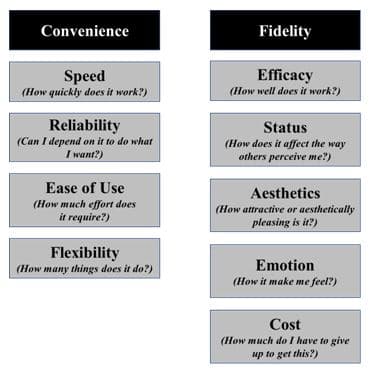by Vinaya Manchaiah, PhD, and Amyn M Amlani, PhD
Most professionals are aware that the FDA Reauthorization Act of 2017 has been passed into law and, as a provision of this bill, the FDA is in the process of developing a category of over-the-counter (OTC) hearing aids for adults with mild-to-moderate hearing loss. Specifically, the FDA is charged with overseeing the safety and labeling requirements for the new OTC category, as well as updating its draft guidance on Personal Sound Amplification Products. Recently, a working group from four US professional hearing healthcare organizations developed and released a consensus paper outlining “five evidence-based recommendations related to safety and effectiveness” to provide guidance to the FDA during its deliberations.
To date, much of the dialogue regarding the safety and effectiveness recommendations has been provided by the supply-side (i.e., manufacturers, practitioners) of the market. To gain a better understanding of the demand-side, or user-side, we undertook a retrospective study of economic values by analyzing the benefits and shortcoming of Direct-to-Consumer Hearing Devices (DCHDs) as reported in Amazon customer reviews.
Economic Values
Economic value is a measure of the benefit perceived by the user towards a good or service in exchange for currency. According to Josh Kaufman’s The Personal MBA, there are nine economic values that people consider when making a purchase: efficiency, speed, reliability, ease of use, flexibility, status, aesthetic appeal, emotion, and cost.
In the book, Trade-off: Why Some Things Catch On, and Others Don’t, Kevin Maney dichotomizes these nine economic values into two primary characteristics: convenience and fidelity. Figure 1 (below) highlights the relationship between the two characteristics and the nine values.

Figure 1. Economic characteristics and values.
Study Details
A detailed search was conducted on the Amazon US website (www.amazon.com) to find all the possible DCHDs between September 2017 and December 2017.
Secondary data was generated by manually gathering user feedback reviews for 62 different DCHDs (cost range $9.95 to $379.99). A total of 12,087 unique feedback reviews was noted for 62 DCHDs devices. These reviews were manually screened and only those that were Amazon verified were extracted, resulting in 11,258 unique user feedback reviews.
The data (i.e., feedback reviews) were analyzed using both quantitative and qualitative methods. First, automated text pattern analysis (i.e., hierarchical clustering based on correspondence analysis) was performed using the open source Iramuteq software to examine the main themes (i.e., economic values) emerging from the larger data corpus (100% of the data). This exercise resulted in seven unique clusters:
(1) Issues related to Fit and Comfort (15%);
(2) Friends and Family Recommendations (11.8%);
(3) Issues related to Sound Quality (11.9%);
(4) Listening and Conversation (16.1%);
(5) Positive Customer Service (12.1%);
(6) General Usage and Customer Service (14.7%); and,
(7) Cost and Affordability (17.3%).
Chi-Square Analyses
Second, a Chi-square analysis was performed to examine the relationship between clusters and the factors of (1) Amazon customer rating and, (2) cost of the device.
First, results revealed that a customer rating of 5 (i.e., highest satisfaction) is significantly over-represented in cluster 2 (i.e., Friends and Family recommendations) and cluster 7 (i.e., Cost and Affordability). Conversely, a customer rating of 5 is significantly underrepresented in cluster 1 (i.e., Issues related to Fit and Comfort) and cluster 3 (i.e., Issues related to Sound Quality). Conversely, a customer rating 1 (i.e., lowest satisfaction) is significantly over-represented in cluster 3 (i.e., Issues related to Sound Quality) and cluster 6 (i.e., General Usage and Customer Service), whereas it is significantly underrepresented in cluster 7 (i.e., Cost and Affordability).
Second, results indicated that low-priced devices DCHDs ($0-$50) are significantly over-represented in cluster 3 (i.e., Issues related to Sound Quality), whereas it is significantly underrepresented in cluster 7 (i.e., Cost and Affordability). Meanwhile, high-priced DCHDs ($201-$500) are significantly over-represented in cluster 7 (i.e., Cost and Affordability) and cluster 6 (i.e., General Usage and Customer Service), but significantly under-represented in cluster 1 (i.e., Issues related to Fit and Comfort) and cluster 2 (i.e., Friends and Family Recommendations).
These results indicate that customer reviews about cheaper DCHDs are related to issues about sound quality, whereas reviews about expensive DCHDs are related to cost and affordability of the device.
Qualitative Analysis
A qualitative content analysis was performed by hand on 10% of the data (i.e., 1126 customer reviews) to look for meaningful units within the data. The qualitative content analysis identified 8 main themes and 40 sub-themes.
The main themes included: (1) Intrinsic factors; (2) Extrinsic factors; (3) Supplemental items; (4) Ease of Use; (5) Interaction with Support Services; (6) Reasons for Purchase; (7) Experiences; and (8) General information. The main sub-themes that occurred more frequently included: Great Sound Quality, Poor Sound Quality, Purchased as a Gift, Satisfactory Experience, Dissatisfactory Experience, and General Information.
Conclusions
- Overall, the study results highlight the benefits and shortcomings of DCHDs which are currently available in the US market.
- Our results yielded a strong association between qualitative and quantitative analysis of the data.
- The customer reviews yielding lower satisfaction rating are related primarily to issues regarding (1) Sound Quality, (2) Fit and Comfort, and (3) General Usage and Customer Service.
- On the other hand, customer reviews with higher satisfaction rating are based primarily on (1) Recommendations made by Friends and Family, and (2) Cost and Affordability.
We hope these findings aid clinicians to better understand the issues consumers face with their DCHDs, and the outcome from this study can also serve as advice to patients during clinical consultations. In addition, these findings might be of interest to hearing instrument and consumer electronics industry from the perspective of developing products, based on users’ feedback.
Study Limitations
- The customer reviews included both first hand (i.e., DCHD users himself/herself) and proxy (i.e., reports from friends and family members of DCHD users) reports. Although both views are important, we did not distinguish between the reviews between these groups (i.e., first-hand versus proxy). Hence, we are unable to report the commonalities and differences in the views of these two groups.
- The automated text pattern analysis employed cluster analysis to identify important themes and also a Chi-square analysis to examine the relation between clusters and other device related factors (i.e., cost, customer rating). While the clustering presents common themes—such as ‘Issues related to Fit and Comfort’ and ‘Issues related to Sound Quality’—it does not distinguish whether they were positive, neutral or negative.
- The customer reviews about DCHDs were only obtained from Amazon. However, review from other forums (e.g., DCHD websites, consumer forums) may have information that were not identified in this study.
References
- It’s official: President Trump signs OTC hearing aid legislation into law. https://hearinghealthmatters.org/hearingnewswatch/2017/trump-signs-otc-hearing-aid-bill-fda-0819/
- Kirkwood, D. H. (2013, November 13). FDA proposes guidance to clarify differences between hearing aids and PSAPs. https://hearinghealthmatters.org/hearingnewswatch/2013/fda-proposes-guidance-clarify-differences-hearing-aids-psaps/
- Professional hearing organizations release consensus recommendations for OTC hearing aid classification. https://hearinghealthmatters.org/hearingnewswatch/2018/consensus-otc-hearing-aid-classification/








It would be nice to see how this kind of analysis would compare to hearing aids purchased through the professional system in order to make a useful comparison. The problem would be in getting objective consumer data from consumer reviews as were obtain from the Amazon site.
We are considering doing such a study and will keep you posted in few months if we can produce some useful analysis through other customer platforms.